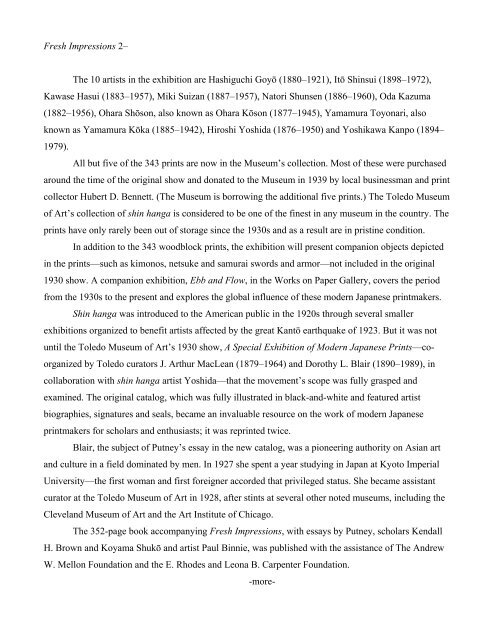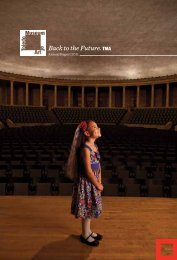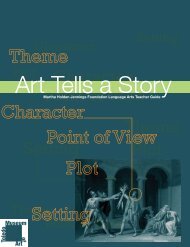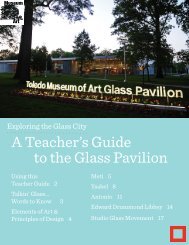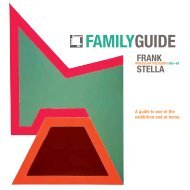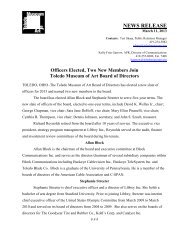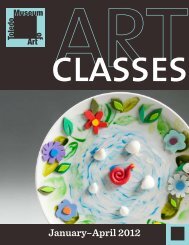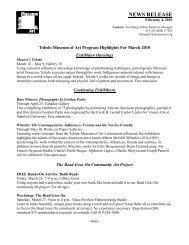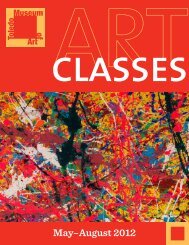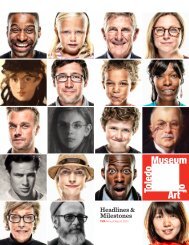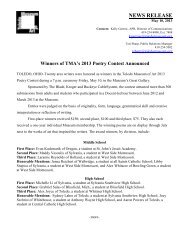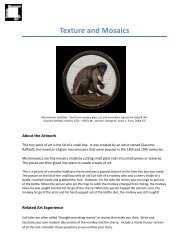NEWS RELEASE - The Toledo Museum of Art
NEWS RELEASE - The Toledo Museum of Art
NEWS RELEASE - The Toledo Museum of Art
You also want an ePaper? Increase the reach of your titles
YUMPU automatically turns print PDFs into web optimized ePapers that Google loves.
Fresh Impressions 2–<br />
<strong>The</strong> 10 artists in the exhibition are Hashiguchi Goyō (1880–1921), Itō Shinsui (1898–1972),<br />
Kawase Hasui (1883–1957), Miki Suizan (1887–1957), Natori Shunsen (1886–1960), Oda Kazuma<br />
(1882–1956), Ohara Shōson, also known as Ohara Kōson (1877–1945), Yamamura Toyonari, also<br />
known as Yamamura Kōka (1885–1942), Hiroshi Yoshida (1876–1950) and Yoshikawa Kanpo (1894–<br />
1979).<br />
All but five <strong>of</strong> the 343 prints are now in the <strong>Museum</strong>’s collection. Most <strong>of</strong> these were purchased<br />
around the time <strong>of</strong> the original show and donated to the <strong>Museum</strong> in 1939 by local businessman and print<br />
collector Hubert D. Bennett. (<strong>The</strong> <strong>Museum</strong> is borrowing the additional five prints.) <strong>The</strong> <strong>Toledo</strong> <strong>Museum</strong><br />
<strong>of</strong> <strong>Art</strong>’s collection <strong>of</strong> shin hanga is considered to be one <strong>of</strong> the finest in any museum in the country. <strong>The</strong><br />
prints have only rarely been out <strong>of</strong> storage since the 1930s and as a result are in pristine condition.<br />
In addition to the 343 woodblock prints, the exhibition will present companion objects depicted<br />
in the prints—such as kimonos, netsuke and samurai swords and armor—not included in the original<br />
1930 show. A companion exhibition, Ebb and Flow, in the Works on Paper Gallery, covers the period<br />
from the 1930s to the present and explores the global influence <strong>of</strong> these modern Japanese printmakers.<br />
Shin hanga was introduced to the American public in the 1920s through several smaller<br />
exhibitions organized to benefit artists affected by the great Kantō earthquake <strong>of</strong> 1923. But it was not<br />
until the <strong>Toledo</strong> <strong>Museum</strong> <strong>of</strong> <strong>Art</strong>’s 1930 show, A Special Exhibition <strong>of</strong> Modern Japanese Prints—coorganized<br />
by <strong>Toledo</strong> curators J. <strong>Art</strong>hur MacLean (1879–1964) and Dorothy L. Blair (1890–1989), in<br />
collaboration with shin hanga artist Yoshida—that the movement’s scope was fully grasped and<br />
examined. <strong>The</strong> original catalog, which was fully illustrated in black-and-white and featured artist<br />
biographies, signatures and seals, became an invaluable resource on the work <strong>of</strong> modern Japanese<br />
printmakers for scholars and enthusiasts; it was reprinted twice.<br />
Blair, the subject <strong>of</strong> Putney’s essay in the new catalog, was a pioneering authority on Asian art<br />
and culture in a field dominated by men. In 1927 she spent a year studying in Japan at Kyoto Imperial<br />
University—the first woman and first foreigner accorded that privileged status. She became assistant<br />
curator at the <strong>Toledo</strong> <strong>Museum</strong> <strong>of</strong> <strong>Art</strong> in 1928, after stints at several other noted museums, including the<br />
Cleveland <strong>Museum</strong> <strong>of</strong> <strong>Art</strong> and the <strong>Art</strong> Institute <strong>of</strong> Chicago.<br />
<strong>The</strong> 352-page book accompanying Fresh Impressions, with essays by Putney, scholars Kendall<br />
H. Brown and Koyama Shukō and artist Paul Binnie, was published with the assistance <strong>of</strong> <strong>The</strong> Andrew<br />
W. Mellon Foundation and the E. Rhodes and Leona B. Carpenter Foundation.<br />
-more-


